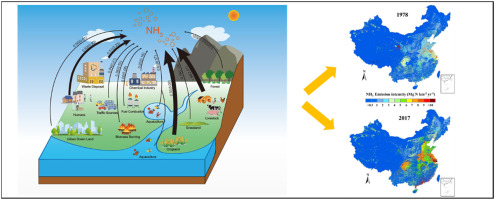当前位置:
X-MOL 学术
›
Atmos. Environ.
›
论文详情
Our official English website, www.x-mol.net, welcomes your
feedback! (Note: you will need to create a separate account there.)
High-resolution assessment of ammonia emissions in China: Inventories, driving forces and mitigation
Atmospheric Environment ( IF 4.2 ) Pub Date : 2020-05-01 , DOI: 10.1016/j.atmosenv.2020.117458 Shiyi Ma
Atmospheric Environment ( IF 4.2 ) Pub Date : 2020-05-01 , DOI: 10.1016/j.atmosenv.2020.117458 Shiyi Ma

|
Abstract Atmospheric ammonia (NH3) is a major air pollutant. China is a global hotspot of NH3 emissions and, as a consequence, comprehensive and high-resolution temporal and spatial assessments and mitigation potential of NH3 emissions are particularly important for the environment, human and ecosystem health. This study demonstrates that national NH3 emissions in China have increased by 102% from 1978 to 2017. Cropland was the major emitter accounting for 38–52% of the emissions, followed by livestock and waste disposal. These three sources accounted for approximately 80% of total emissions nationwide over the past four decades. NH3 hotspots (NH3 emission densities > 5 Mg N km−2 yr−1) were scattered in the Bohai Rim region, North China Plain, the Middle and Lower Yangtze River and the southeast coast in 1978. By 2017, the hotspots had expanded to a larger area of the North China Plain, the Middle and Lower Yangtze River and the Sichuan Basin. In 1978, these hotspots occupied about 2% the land area and contributed to about 46% of total NH3 emissions. By 2017, the hotspots expanded to about 12% of the land area and contributed to more than 70% of the emissions. This study also performed the driving force analysis and found that the population growth had a crucial impact on NH3 emissions with an annual contribution degree of 183%, while the per capita GDP and the urbanization were negatively correlated with NH3 emissions. The analysis of six mitigation scenarios indicates that adopting measures from the production side (including larger farm size, 4 R nutrient stewardship, low emission housing and waste treatment tail gas management) will generate 10–15% reduction potential, whereas encouraging healthy and reasonable diet scenario will reduce 26% by 2030. These findings substantially improve our understanding on NH3 emissions and have implications for air pollution control strategies and policy measures.
更新日期:2020-05-01











































 京公网安备 11010802027423号
京公网安备 11010802027423号